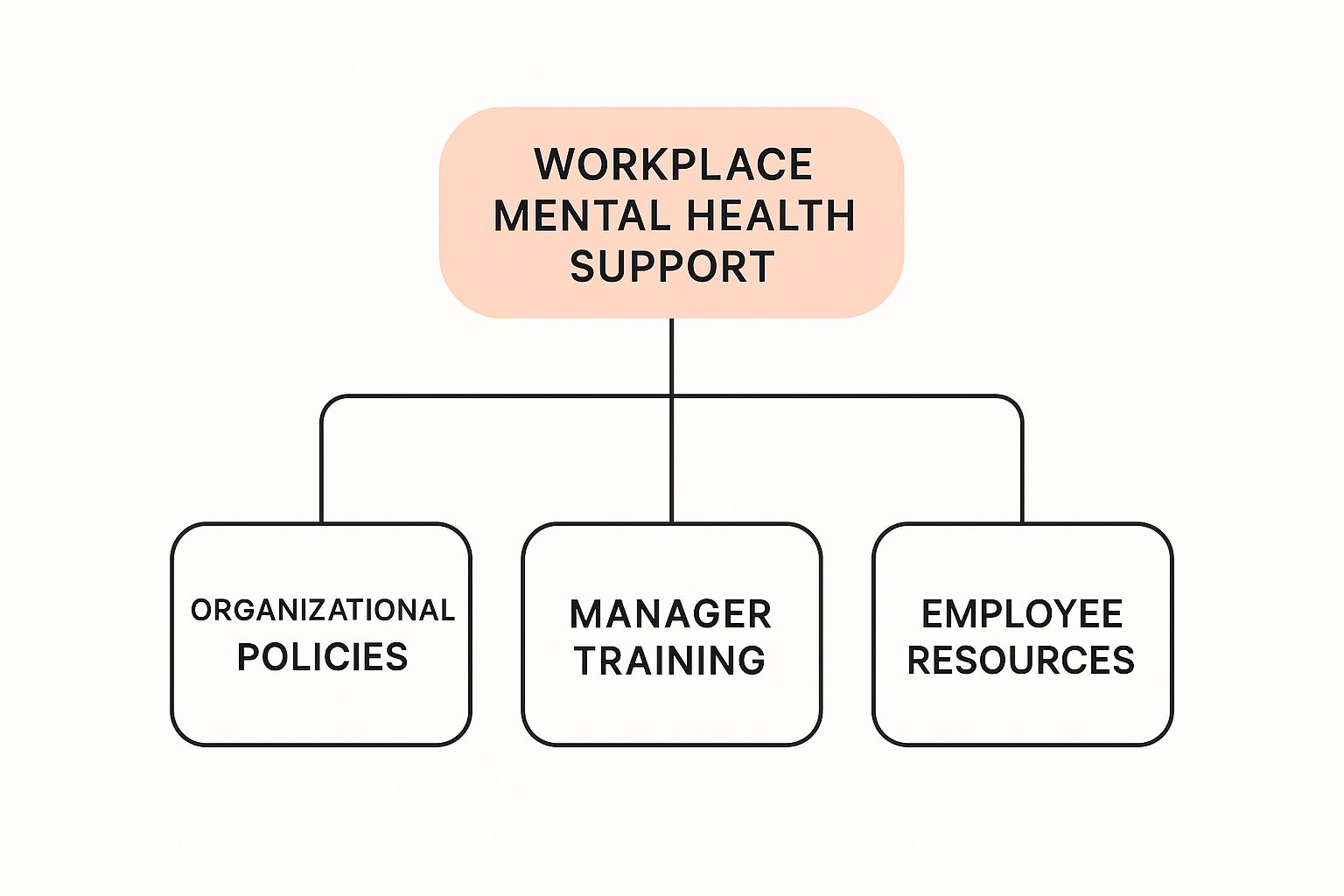Let's be clear: true mental health support at work isn't just a wellness app or a new program. It’s about building a culture of trust. It starts by creating an environment where your team feels safe enough to be human—to be vulnerable, make mistakes, and ask for help without fearing it will cost them their job.
This psychological safety is the bedrock of a resilient, creative, and high-achieving team. Let's build it together.
Building a Culture of Psychological Safety
This is where support moves beyond buzzwords and becomes part of your team's DNA. It’s about leaders modeling vulnerability, practicing active listening that makes people feel truly heard, and setting clear boundaries that protect everyone’s time and energy.
When psychological safety is real, innovation and honesty flourish. Yet, a huge gap often exists between what companies say and what employees experience. Stigma remains a powerful barrier that keeps people silent.
A NAMI Workplace Mental Health Poll revealed a critical insight: while employees want mental health resources, many are deeply unsure if their workplace is a safe place to have these conversations. This is a clear call to action for leaders to stop waiting and start building that safety net.
From Fear to Trust
You can't have psychological safety without trust. It’s that simple. Without it, your team will hesitate to share innovative ideas, admit small mistakes before they become big ones, or voice legitimate concerns. This hesitation stifles growth and collaboration.
Leaders can lay this foundation by being consistent, reliable, and showing genuine care for their team members as people. The goal is to shift the entire dynamic from a fear of speaking up to a culture of mutual respect. A great starting point is to explore proven strategies to build trust in theworkplace.
This kind of support system relies on everyone—from the organization to individual managers—doing their part.

As you can see, effective support isn’t a single initiative. It's a multi-layered effort that ensures help is accessible from every angle.
Practical Steps for Leaders
Building psychological safety is about small, intentional, everyday actions that signal to your team that it’s safe to be authentic.
- Model Vulnerability: When you openly say, “I’m feeling overwhelmed by this deadline,” it gives your team permission to be human, too.
- Encourage Respectful Dissent: Actively invite different perspectives. Try saying, “Does anyone see a different way to approach this?” This can transform quiet groupthink into powerful debate.
- Respond with Curiosity, Not Judgment: When an employee brings you a problem, your initial reaction sets the tone. Instead of a sharp “Why did you do that?” try a calmer, “Can you walk me through your thought process?”
Pillars of Psychological Safety at Work
| Pillar | Leader Action | Expected Outcome |
|---|---|---|
| Open Communication | Regularly ask for feedback and model vulnerability by sharing personal challenges. | Employees feel safe to share ideas, concerns, and admit mistakes without fear of blame. |
| Inclusion & Belonging | Actively solicit diverse perspectives and ensure everyone's voice is heard and respected. | Team members feel valued for their unique contributions, leading to higher engagement. |
| Support for Risk-Taking | Frame mistakes as learning opportunities and celebrate intelligent failures. | Innovation and creativity flourish as people feel free to experiment and think outside the box. |
| Clarity & Respect | Establish clear roles, expectations, and boundaries that protect everyone's well-being. | Reduced ambiguity and burnout, as team members know what is expected and feel respected. |
These pillars are the daily practices that transform a workplace from a place of fear to a place of trust and high performance.
"Psychological safety isn't about being nice. It's about giving candid feedback, openly admitting mistakes, and learning from each other." - Amy Edmondson, Harvard Business School Professor
Creating this supportive atmosphere is a critical part of fostering a healthy and dynamic team.
Designing Benefits That Actually Help
Let's be honest: the old EAP flyer on the breakroom bulletin board isn't cutting it anymore. To make a real impact, the support you offer must be modern, confidential, and genuinely useful for the challenges people face today.
The entire conversation around workplace mental health is shifting. A recent global report by Deloitte shows that leading companies are ditching traditional EAPs for more sophisticated, tech-enabled solutions. They're focusing on personalized care, recognizing that daily stress requires different support than a clinical diagnosis.
Your investment needs to go toward partners who can support the full spectrum of mental wellbeing.
What Modern Support Looks Like
Choosing the right benefits partner is about finding concrete tools that will actually get used.
Here are the non-negotiables to look for:
- User-Friendly Digital Platforms: Getting support should be as easy as ordering coffee on your phone. Look for intuitive apps, simple booking, and on-demand resources like guided meditations.
- Diverse and Vetted Provider Networks: Your team is not a monolith. Your partner must offer a network of therapists and coaches from various cultural backgrounds, specialties, and languages. Representation matters.
- A Clear Path to Care: The best platforms make the journey from feeling overwhelmed to talking to a professional seamless, quickly connecting them to the right level of care.
Inclusive and Specialized Support
Great mental health support has to be inclusive. This means thinking about the specific needs of all your employees, including neurodivergent team members. To make your benefits truly comprehensive, it's worth exploring strategies for implementing effective autism workplace accommodations.
Investing in a comprehensive benefits strategy is a powerful statement that you see your employees as whole people. It communicates that their wellbeing is a core component of the company's success.
When you invest in benefits that are personalized and accessible, you’re not just checking a box. You’re building a genuine system of care that empowers your team to thrive.
Training Leaders to Be Supportive Allies

Your managers are the most direct link to your team's daily experience, making them your first and most vital line of defense in supporting mental health in the workplace.
But let’s be crystal clear: their role isn’t to be a therapist. Their mission is to become compassionate allies who know how to create a safe space for conversation.
When you empower them with the right training, you transform them from observers into confident first responders. This isn't about teaching them to diagnose problems. It’s about equipping them to notice distress, start a supportive conversation, and guide employees toward professional resources.
Shifting from Managing to Supporting
Impactful training moves beyond an HR checklist. It’s about building emotional intelligence and practical communication skills. The goal is to help leaders recognize when someone on their team might be struggling.
This could look like a change in behavior, a drop in engagement, or increased irritability. The key is to notice these shifts with empathy, not judgment. Amazon is a great example of this at scale, having trained thousands of managers globally to build empathy and connect employees with the right help.
A supportive leader doesn’t need all the answers. They just need to know how to listen and where to point people for help. This simple shift can make all the difference.
The Ally's Toolkit: What to Teach
Effective training gives your managers a practical toolkit for navigating delicate situations.
- Spotting the Signs: Teach leaders to recognize subtle indicators like changes in work quality, social withdrawal, or uncharacteristic emotional responses.
- Starting the Conversation: Give them simple, non-invasive conversation starters. Instead of “Are you okay?” try something more open-ended, like: “I’ve noticed you’ve been quieter in meetings lately. How are things going?”
- Navigating with Confidentiality: Clarify the boundaries of privacy. Managers must understand what they can and cannot ask and how to handle sensitive information with respect.
- Connecting to Resources: Make sure every leader knows exactly how to direct employees to your EAP, benefits platform, or other mental health resources. The process must be simple and clear.
Integrating Wellness Into Your Daily Workflow
The best mental health support isn’t a program you roll out once a year; it’s a culture you live every day. Real wellness is woven into the fabric of your team's rhythm, not tacked on as a benefit.
It’s all about creating an environment where well-being is part of how great work gets done. When you intentionally build wellness into your daily operations, you send a powerful message: we care about you as a whole person.
Protecting Time and Energy
One of the most profound ways to support your team’s mental health is to fiercely protect their time. A constant barrage of interruptions and an "always-on" culture are surefire recipes for burnout.
- Action Point: Implement a “no-meeting Wednesday” to give everyone a guaranteed block of time for deep, uninterrupted work.
- Action Point: Set clear boundaries around after-hours communication. A simple policy discouraging emails after 6 PM helps protect personal time and prevents mental fatigue.
Fostering Genuine Connection
While deep focus is critical, so is genuine human connection. Loneliness and isolation can be huge stressors, but you can fight back by creating intentional spaces for your team to connect.
- Action Point: Kick off meetings with a quick, casual question like, "What's a small win you had this week?"
- Action Point: Use a tool to randomly pair up team members for a 15-minute virtual coffee chat to build cross-departmental relationships.
- Action Point: Make a point to acknowledge birthdays, work anniversaries, and other personal milestones.
These small moments build the social glue that helps teams support one another through stressful times.
The goal is to design a workflow where rest isn't a reward for exhaustion, but a fundamental part of doing your best work. When your team is rested and connected, their creativity and engagement will naturally follow.
Weaving wellness into your workflow is about building healthier habits together. A daily self-care checklist can be a great starting point for personal well-being that perfectly complements a supportive work environment.
The Business Case for Mental Health Support
Let’s be clear: investing in your team’s mental health isn't just a kind gesture. It's one of the sharpest business strategies you can adopt. A team that feels supported fuels productivity, sparks innovation, and sticks around for the long haul.
It's time to stop seeing mental health as a cost center and recognize it as a core driver of success.
Ignoring employee wellbeing comes with a steep price. Globally, poor mental health has staggering economic consequences. The World Health Organization's report on mental health at work estimates that depression and anxiety cost the global economy US$ 1 trillion each year in lost productivity.
ROI on Employee Wellbeing
The numbers don't lie. Proactive mental health support in the workplace delivers a powerful return. A WHO study found that for every $1 invested in treating common mental health conditions, there is a return of $4 in improved health and productivity.
That return shows up in tangible ways. A supportive environment dramatically cuts down on absenteeism and presenteeism—when people are physically at their desks but mentally checked out. By getting ahead of burnout and stress, you build a workforce that's more resilient, focused, and loyal.
Proactive vs Reactive Approaches
Waiting for a crisis isn't a strategy; it's a liability. A proactive approach builds a foundation of support that can prevent many issues from spiraling. A reactive stance means you're always playing catch-up, trying to fix problems that have already done damage.
This table illustrates the fundamental differences.
Comparing Proactive vs. Reactive Mental Health Strategies
| Strategy Feature | Proactive Approach | Reactive Approach |
|---|---|---|
| Focus | Prevention, skill-building, and fostering a supportive culture. | Crisis intervention and addressing problems after they've surfaced. |
| Cost | Consistent, predictable investment in benefits and training. | High, unpredictable costs from turnover, absenteeism, and low morale. |
| Outcome | Higher engagement, increased innovation, and strong employee loyalty. | Burnout, high employee turnover, and damage to company reputation. |
The proactive path is about building strength from the inside out. It's a sustainable model that protects both your people and your bottom line.
Embracing a proactive mental health strategy is an investment in your company's most valuable asset—its people. It’s the difference between merely surviving and building a culture where everyone can truly thrive.
How to Measure Your Impact and Sustain Momentum

Launching a mental health initiative is a great first step, but the real magic happens in the follow-through. To build a program that lasts, you must measure what’s working, adapt to what isn’t, and keep the energy alive.
This isn't about perfection; it's about progress. Creating a cycle of continuous improvement is the only way mental health support in the workplace becomes a cornerstone of your culture, not just another forgotten project.
Listening for the Real Story
To get a true sense of your impact, you need unfiltered feedback. Anonymous channels are your most powerful tool for understanding what your team is actually experiencing.
You need to create safe, reliable ways for people to share their thoughts without fear. This is how you find out if your resources are actually being used and if they're helpful.
- Action Point: Use anonymous pulse surveys with specific questions about psychological safety, workload, and resource awareness.
- Action Point: Hold confidential focus groups, facilitated by a professional, to dig into deeper feedback on your culture.
- Action Point: Create a digital or physical suggestion box for an always-on channel for ideas or concerns.
Tracking Metrics That Actually Matter
Beyond stories, you need to track data that reveals your team's wellbeing. These numbers can help you spot trends, justify investment, and pinpoint areas that need more attention.
Sustaining momentum is about proving that your efforts are making a difference. When you can connect your initiatives to real business outcomes, you create a compelling case for continued focus.
Keep an eye on key indicators like:
- Usage rates of your EAP or mental health benefits
- Changes in employee turnover and absenteeism
- Scores on engagement surveys related to wellbeing
By regularly reviewing these metrics, you shift from guessing what your team needs to knowing. This data-informed approach lets you celebrate wins and strategically pivot your efforts where they'll make the biggest difference.
Answering Your Toughest Questions About Workplace Mental Health
Stepping into mental health support at work can feel like walking a tightrope. You want to be there for your team while respecting personal and legal boundaries. It’s normal to have questions, so let's tackle the most common ones.
One of the biggest hurdles is privacy. How do you offer support without prying? Shift your focus from diagnosing to providing resources. Instead of trying to figure out what's wrong, simply observe and guide.
For example, you could say, "I've noticed you seem a bit disconnected lately, and I just wanted to remind you that our EAP is a completely confidential resource if you ever want to talk to someone." It’s an approach that shows care while pointing them toward professional, private support.
Then there's the legal side. Many leaders fear saying the wrong thing. The best way to navigate this is to ensure any support is handled consistently for everyone. When an official request for accommodation comes up, always loop in HR to ensure everything is managed fairly and by the book.
How Do I Get My Team to Actually Use These Resources?
This is the big one. You can have the best benefits in the world, but they're useless if no one trusts or uses them. Building that trust starts with chipping away at stigma.
As a leader, you set the tone. You don't have to share your deepest personal stories, but talking about mental health as a normal part of life is incredibly powerful. When you mention taking a mental health day or remind the team about wellness benefits, you send a clear message.
When leaders treat mental wellbeing as a vital part of overall health, it gives everyone else permission to do the same. This consistent, vocal support is what transforms a program into a trusted cultural norm.
What If I Don’t Have a Big Budget?
Meaningful support isn’t about how much you spend. Many of the most powerful initiatives are about changing the culture, and that doesn't have to cost a dime.
Here are a few high-impact, low-cost ideas:
- Promote Flexible Schedules: Giving your team more control over their work can drastically reduce stress.
- Encourage "No-Meeting" Blocks: Protect your team’s deep work time to help them avoid burnout.
- Lead with Empathy: A manager who genuinely listens and responds with compassion is one of the most powerful mental health resources a person can have. It's free, and it's everything.
These simple strategies prove that you don’t need a massive budget to create a supportive, mentally healthy workplace. It’s accessible to every organization, no matter the size.
At Mesmos, we believe that small, intentional acts of mindfulness can create a profound sense of peace and wellbeing. Discover our collection of thoughtful gifts and stationery designed to inspire calm and creativity in your daily life by visiting us at https://mesmos.co.
